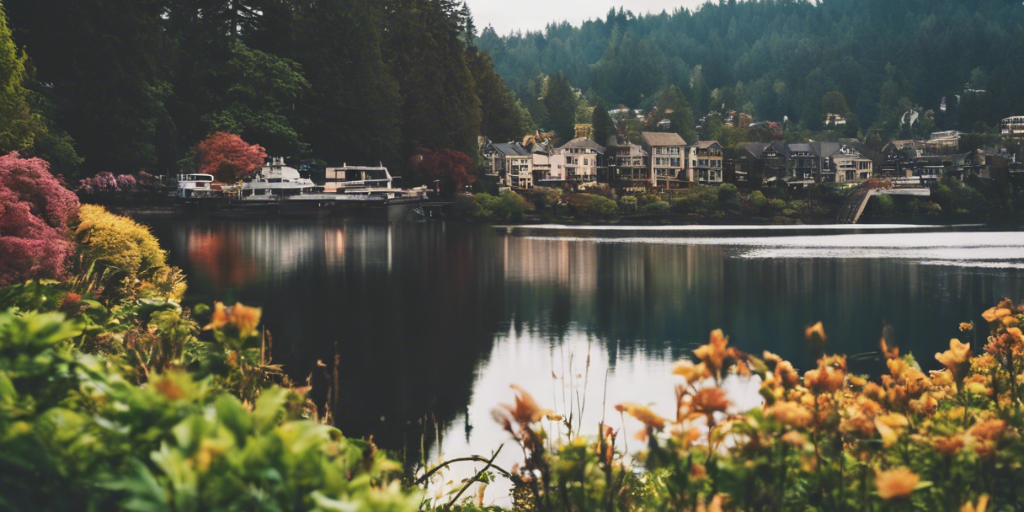Nestled just eight miles southwest of Portland, Lake Oswego emerges as a remarkable testament to the fusion of historical richness and natural splendor within the Willamette Valley. Revered as one of the oldest inhabited areas in the valley, it captivates visitors and residents alike with scenic river views, fertile fishing grounds bustling with salmon and lamprey, and expansive camas meadows stretching into the Tualatin Valley. This unique blend of attributes sets the stage for a journey through Lake Oswego’s storied past and vibrant present.
The legacy of Lake Oswego is deeply intertwined with the indigenous heritage that predates modern settlement, echoing through time with tales of tribes who regarded these lands as sacred. Coupled with its transformation into an industrial and residential hub—spurred by the Oregon Donation Land Act and the inception of the iron industry—Lake Oswego’s narrative is a compelling chronicle of human endeavor and natural beauty. As we delve into its historical tapestry, from native origins to iron prowess and railroad development, Lake Oswego stands as a beacon of progress in the heart of the Pacific Northwest.
Lake Oswego’s Indigenous Heritage
Long before Lake Oswego became known by its current name, it was a thriving habitat for Indigenous peoples. The Clackamas, Clowewallas, and Tualatins were among the tribes that lived off this land for over 6,100 years, as noted by archeological findings in the area. The lake that is central to the city was named “waluga” by the Native people, which translates to “swan,” highlighting the abundant wildlife that the area supported.
The significance of the land extended beyond its natural resources. The Willamette Meteorite, one of the largest meteorites to have landed in North America, was located nearby. Indigenous locals believed the meteorite’s waters bestowed their arrows with a mystical potency, crucial for hunting success and defense. This reverence underscores the deep spiritual connection between the people and their environment.
The translation of “Oswego” from the Iroquois phrase meaning “where the valley widens” perhaps best encapsulates the essence of Lake Oswego’s origins. Its geographical expanse and natural bounty have always set it apart as a place of gathering and living, a tradition that continues to this day. This blend of rich history and natural beauty is what makes Lake Oswego a spellbinding chapter in the Pacific Northwest’s tapestry.
Lake Oswego: From Donation Land to Iron Powerhouse
The transformative Oregon Donation Land Act of 1850 marked a pivotal chapter in Lake Oswego’s development. By granting free land, this legislation invited a wave of settlers eager to shape their destiny in the Oregon Territory. Among them were Miranda and Alonzo Durham, who, captivated by the land’s accessibility to the Willamette River, laid the foundation of Oswego’s iron saga by establishing Oregon’s inaugural iron producer.
The iron industry’s roots deepened with the establishment of the Oregon Iron Company in the late 19th century, signaling the birth of the Pacific Northwest’s first iron smelter. This ambitious venture catalyzed a burgeoning industry that, at its zenith, produced a staggering 12,305 tons of iron, carving Oswego’s place in the region’s industrial annals.
Despite the iron industry’s decline due to competitive pressures from high-quality Great Lakes iron, one of the original smelters still stands proudly in George Rogers Park today. This enduring relic serves as a testament to Oswego’s industrious past and its pivotal role in the broader narrative of Oregon’s economic ascent.
The Railroad Revolution in Lake Oswego
Before the advent of the railroad, Lake Oswego was a secluded enclave, accessible only by arduous dirt roads or riverboat navigation. However, the transportation landscape dramatically shifted in 1886 when the Southern Pacific Railroad extended its reach into the city’s heart. This crucial development directly connected Lake Oswego to Portland, bridging the gap between the remote town and the bustling urban center.
With the railroad’s arrival, Lake Oswego experienced unprecedented growth and prosperity. The early 20th century saw the rail lines electrified, facilitating even more significant residential development across the area. Lake Oswego transformed, boasting a vibrant community complete with general stores, banks, hotels, and an array of local businesses, enriching the city’s social tapestry.
The railroad’s influence was a double-edged sword for the local iron industry, prompting its decline in favor of the burgeoning residential sector. Despite this, the railroad’s legacy lives on, underpinning Lake Oswego’s evolution into a thriving suburb with robust connectivity to Portland. This period of expansion not only reshaped the city’s infrastructure but also laid the groundwork for the modern, interconnected community Lake Oswego is today.
Lake Oswego’s Expansion: Mountain Park
The establishment of Mountain Park in 1970 marked a significant turning point in the development of Lake Oswego. Notably, this area now accommodates one-quarter of the city’s population, showcasing its appeal as a desirable living space. The strategic annexation of Mountain Park effectively doubled the city’s tax base and population, bolstering Lake Oswego’s economic and social fabric. Interestingly, Mountain Park is constructed on an active volcano, offering the highest elevation in Lake Oswego at 958 feet, adding a unique geological aspect to the community.
This expansion set the stage for further development, with areas like Holly Orchard and Foothills following suit. Each addition contributed to the city’s growth, diversifying the community and enhancing the local lifestyle options available to residents. With a focus on integrating urban development with the natural beauty of the surroundings, Lake Oswego has successfully balanced growth with environmental stewardship.
Today, Lake Oswego boasts 600 acres of parks and open spaces, evidencing the city’s commitment to preserving its natural allure. George Rogers Park and Foothills Park, particularly noted for their scenic views along the Willamette River, stand as testaments to the city’s dedication to communal and natural well-being. These developments encapsulate Lake Oswego’s evolution from a single neighborhood to a vibrant city of over 25 neighborhoods, all while maintaining its charm and connection to the environment.
Lake Oswego’s Population Growth
Since its founding, Lake Oswego has witnessed remarkable population growth. From a fledgling community of just 97 residents in 1880, the city flourished into a bustling suburb with a population of 35,278 by the year 2000. This growth reflects Lake Oswego’s evolution from a small settlement to a vibrant city.
Legacy and Growth: Lake Oswego’s Journey Forward
Lake Oswego’s transformation from an indigenous haven to a modern-day sanctuary reflects its enduring allure and adaptability. With a rich tapestry of history that includes significant industrial development and a profound connection with the natural world, the city continues to evolve while honoring its past. The careful stewardship of its scenic landscapes and a commitment to community and cultural heritage position Lake Oswego as a unique blend of tradition and progress.
Amidst this growth, Lake Oswego remains a testament to what communities can achieve when they embrace their history with an eye toward the future. The city’s journey from a humble settlement to a thriving suburb showcases not just the resilience of its people but also their commitment to creating a vibrant city. With every park, street, and building, Lake Oswego continues to weave its story, adding new chapters that future generations will cherish and build upon.
If you’re looking for places in Lake Oswego to visit, this is a great video to watch:








